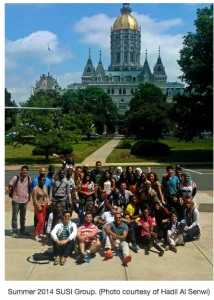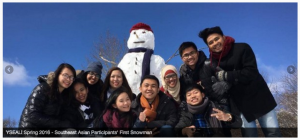There is little doubt that human rights is an intriguing topic to folks from all walks of life! From freshman in college to the elderly, people tend to be curious and interested in learning more about their rights, and the diverse landscape of international human rights. Offerings of human rights courses are growing in the academy, yet there are many academics who cannot devote a full semester to teaching rights. If one is willing to think outside the box there are many ways to incorporate rights into various academic programs and/or courses that are not specifically billed as human rights.
Obviously there are many types of academic programs that do not fit squarely into the semester timeframe: afterschool programs, lecture series, exchange programs, conferences, mini-camps, team building excursions, and as discussed in a previous blog post field trips. The range of differing time restraints and/or programs is too broad to address here, but one thing they often share is opportunities to employ a rights based segment into programing but face a limited time constraint to do so. Of course, this depends on the relevant content of the program—there is not much rights discourse analysis presented in your typical “Physics Camp” but maybe there could be J. I have been fortunate enough to be able to incorporate rights based lessons into U.S. State Department funded exchange programs, including President Obama’s new signature academic exchange program Young Southeast Asian Leaders Initiative (YSEALI), and the long running Study of the U.S. Institute (SUSI) program.
At the University of Connecticut, 20 young African leaders and 40 young Southeast Asian leaders come through our programs run by UConn’s Global Training and Development Institute, where the focus is on social entrepreneurship. Students hail from 10 Southeast Asian countries (YSEALI) and 10 countries in North and West Africa (SUSI) and while participating in these very competitive programs they develop social enterprises, interact with U.S. citizens/instructors, and go on a week-long educational study tour to New York, Philadelphia, and Washington D.C. They stay in the U.S. for five weeks, four of them at UConn, and then return home to their countries to begin the difficult work of scaling up their enterprises and creating social change. Our program’s learning objectives focus broadly on social entrepreneurship, the study of U.S. history and culture, and on leadership. I am employed as a postdoctoral fellow with a component of my job being to design the academic curriculum and our broad learning objectives have allowed me significant space to incorporate human rights into the programming. One need not look very far to see the impact of rights in learning outcomes as student projects have ranged from anti-discrimination programs in Algeria, Morocco, and Indonesia, to new recycling programs in Senegal, Cameroon, the Philippians, to bridging the digital divide among the poor, rural Malian population and the urban elites.
There are four primary ways that I have incorporated human rights that have been particularly effective and might be of use to other faculty or administrators adding rights to an academic program/course: (1) direct academic sessions on human rights; (2) academic sessions that indirectly address components of rights; (3) an online portion that allows for continued engagement with rights after the program concludes; and finally (4) informal simulations and icebreakers focused on creating cross-cultural respect.
We define the “social” part of social entrepreneurship (SE) broadly to include many areas of social change. Human rights fits nicely under this broad umbrella. Thus, as mentioned above (1), I have included traditional academic sessions that directly address rights with titles such as “Introduction to Human Rights,” and “Economic Rights in the U.S. and Beyond.” These hour or so long sessions fit into the program goal to enhance students’ understanding of the “social” in SE and how their social enterprise may employ/or uphold human rights to achieve goals of their local community. Direct knowledge of human rights, especially those related to their particular causes can help our students’ incipient organizations get community and international support for what they are trying to accomplish. Students with little or no human rights background seem to get a lot out of these introduction type sessions—especially if there is a dynamic presenter who mixes up lecture, activities, and powerful use of human rights in multimedia form.
Second, I have included sessions that do not directly address human rights but are indirectly related. These sessions have included: Freedom of the Press in the U.S., African American Leaders and the Civil Rights Movement; Global Environmental Issues; Microfinance; and Social Mobilization which focuses on large scale social movement tactics across different political systems around the world. Elements of human rights are never very far afield from the content and students often make the connections to rights quite easily (especially if they have had the intro to rights sessions beforehand). An added bonus is that these sessions can cover aspects of the program that need to be covered, such as American history/culture in our program.
Third, I include a hybrid online portion of the academic program where students have digital lessons to complete before, during, and after our “on the ground” segment of the program is completed and students have returned home. Thus, they are able to do follow-up readings on rights and continue conversations from the classroom in the online realm. After they complete our full program, including receiving seed funding to start their enterprise, we point them in the direction of the vastly expanding free MOOC options for further learning (see a related post for more info about the potential power of the hybrid model).
Finally, an added bonus of “a rights based component” is that it has fostered strong bonding and the respect of differences among our often disparate groups. Our programs are intentionally diverse, with U.S. Embassies abroad choosing students from different religious, cultural, political, and economic backgrounds (not to mention from 10 different countries). Thus, we have found that the more we can foster mutual respect the smoother the program runs and it leads to closer bonds between the participants. We have included cross-cultural understanding activities, for instance a Peace Corps’ favorite Bafa Bafa (lesson plan for it here from NYU), a business negotiation simulation called Russian Railroad, Circles, Triangles, and Squares which is a simulation about power dynamics among groups, and also many simple icebreaker type games which have helped our students practice the mutual respect that they have been exposed to in the classroom and apply it to real world cross cultural dialog.
Of course, none of these options substitute for the depth of a full semester focused on rights, however they certainly have added a strong rights component to our program without sacrificing overall program goals. In fact, my experience has led me to want to “give them a little more rights” whenever I can J. Giving students “a little more rights” could work in a variety of settings beyond the aforementioned programs. For instance adding a section on rights can really expand the international strength of a traditional course. The icebreaker type activities could be used in almost any classroom, and who knows maybe even at a future “Physics Camp.” A little human rights education can clearly go a long way. Feel free to share your experiences bringing the study of rights into programs/courses and to contact me if you want more detail on any of the activities mentioned above.

